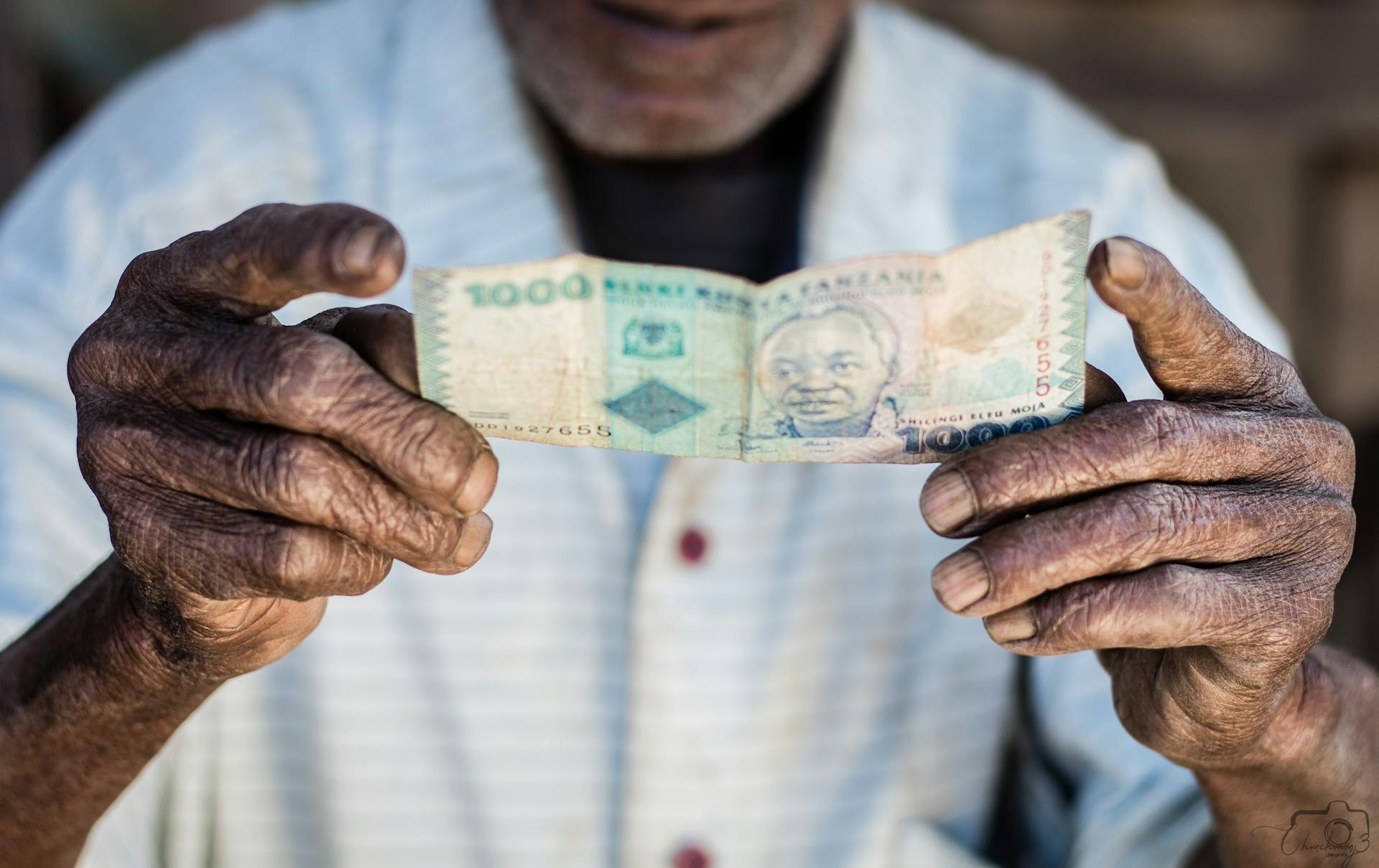
Uganda's local currency is the Ugandan shilling (UGX). It's the official medium of exchange in the country.
The Ugandan shilling is subdivided into 100 cents, but you'll rarely see prices quoted in cents.
You can exchange your money at banks, forex bureaus, or use an ATM to withdraw cash.
Currency Value and Exchange
The Ugandan shilling has had its fair share of changes over the years.
The first Ugandan shilling was introduced in 1966, replacing the East African shilling at par.
This change was made to achieve currency independence.
The first Ugandan shilling was used until 1987, when it was replaced by the second Ugandan shilling due to inflation.
The second Ugandan shilling was introduced with a ratio of 1 new shilling to 100 old shillings.
This change was also a result of inflation.
You can transfer money to Uganda up to 8 times cheaper than traditional banks.
For your interest: Currency Uganda Shilling
Currency Comparison
The Ugandan Shilling is the local currency of Uganda, and it's used alongside the US dollar in some tourist areas.
In Uganda, the Ugandan Shilling is subdivided into 100 cents.
You can exchange your money for Ugandan Shillings at banks, forex bureaus, or currency exchange offices.
The Ugandan Shilling is not a widely traded currency, which means its value can fluctuate significantly.
The exchange rate is not fixed, so it's essential to check the current rate before exchanging your money.
The Ugandan Shilling is accepted as a form of payment in most businesses, markets, and street vendors throughout the country.
Ugandan Shilling Details
The Ugandan Shilling Details section will provide an overview of the local currency used in Uganda. The Ugandan Shilling is the official currency of Uganda, with the Bank of Uganda serving as its central bank.
The Ugandan Shilling has a range of coins and banknotes in circulation. Coins include denominations of 5/=, 10/=, 50/=, 100/=, 200/=, 500/=, and 1,000/=, while banknotes come in denominations of 1,000/=, 2,000/=, 5,000/=, 10,000/=, 20,000/=, and 50,000/=.
The Ugandan Shilling has undergone several changes over the years. In 1987, new coins were introduced, featuring copper-plated-steel and stainless-steel materials. In 1998, coins for 50/=, 100/=, 200/=, 500/=, and 1,000/= were introduced.
Here are the current circulating coins in Uganda:
New banknotes were introduced in 2010, featuring a harmonized design that depicts Uganda's rich historical, natural, and cultural heritage. These notes also include improved security features, making them more difficult to counterfeit.
Exchange and Rates
The Ugandan shilling has had its fair share of changes over the years. The first Ugandan shilling was introduced in 1966, replacing the East African shilling at par.
There have been two versions of the Ugandan shilling so far. The first one was used from 1966 to 1987, when it was replaced by the second Ugandan shilling due to inflation.
Here's a brief history of the Ugandan shilling's exchange rates:
- The first Ugandan shilling was replaced by the second Ugandan shilling in 1987 due to inflation, with a ratio of 1 new shilling = 100 old shillings.
- The second Ugandan shilling has been the official currency of Uganda since 1987.
3,686.38446
The exchange rate for the Ugandan Shilling is a significant one, coming in at 3,686.38446. This is just one example of the many exchange rates you can find when transferring funds internationally.
Discover more: Where Can I Get the Best Currency Exchange Rate

You have the option to transfer to 130+ countries, making it a convenient option for those with international financial needs. This is a testament to the global reach of international money transfers.
With 98+ currencies available to transfer to, you can easily find the right exchange rate for your needs. Whether you're sending money to a friend or family member, or conducting business with international partners, this is a valuable resource to have.
I've seen firsthand how important it is to have access to multiple currencies when sending money abroad. It's a game-changer for those who need to navigate complex financial situations.
Recommended read: Usd Currency Exchange
Exchange Rates
Exchange rates can be a bit confusing, but let's break it down. The Ugandan shilling has had its fair share of changes over the years.
The first Ugandan shilling was introduced in 1966, replacing the East African shilling at par. This happened because Uganda wanted to have its own independent currency.
Expand your knowledge: Does Canada Have Their Own Currency
The first Ugandan shilling was used from 1966 to 1987. After that, it was replaced by the second Ugandan shilling due to inflation.
The second Ugandan shilling was introduced in 1987 and is still in use today. It was introduced because of the high inflation rate at the time.
You can transfer Ugandan shillings to 130+ countries, and there are 98+ currencies available to transfer to. This is great news for travelers and expats who need to send money abroad.
Here are some key facts about the Ugandan shilling:
- ISO 4217 code: (no specific code mentioned in the article)
- Circulating currency: yes
- Currency of Africa: yes
- Currency of Uganda: yes
- Introduced in 1966: yes
- Shilling: yes
Frequently Asked Questions
What is the best currency to bring to Uganda?
For a smooth trip to Uganda, bring US Dollars for major transactions and exchange some for Ugandan Shillings for local purchases. This combination will help you navigate Uganda's dual-currency economy.
Can I use US dollar in Uganda?
Yes, US dollars are widely accepted in Uganda, and you can exchange them for the local currency at banks and forex bureaus throughout the country.
Sources
Featured Images: pexels.com


